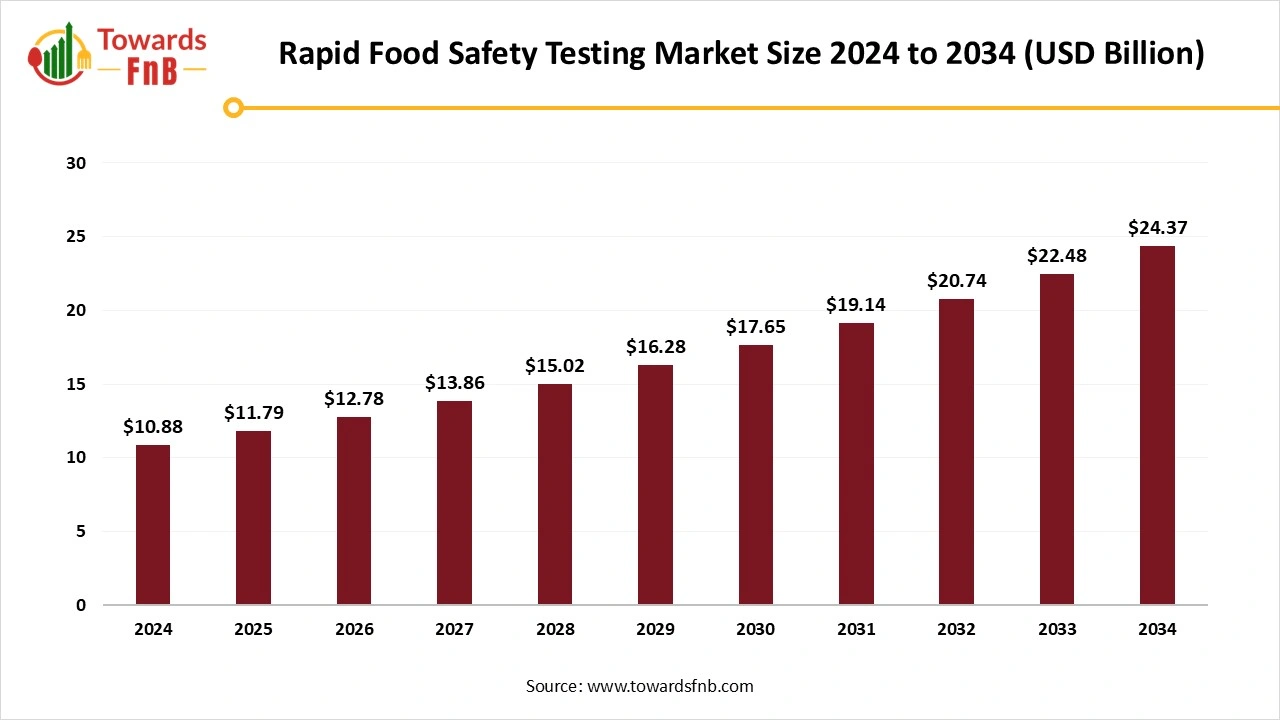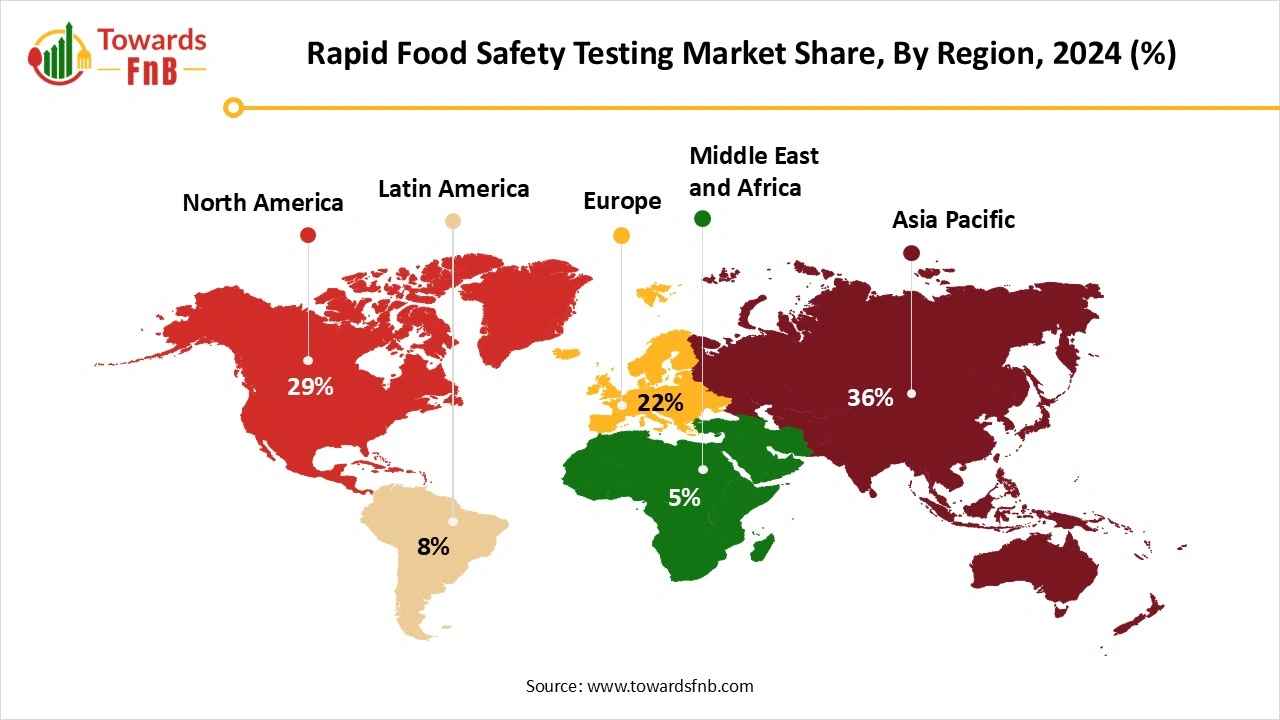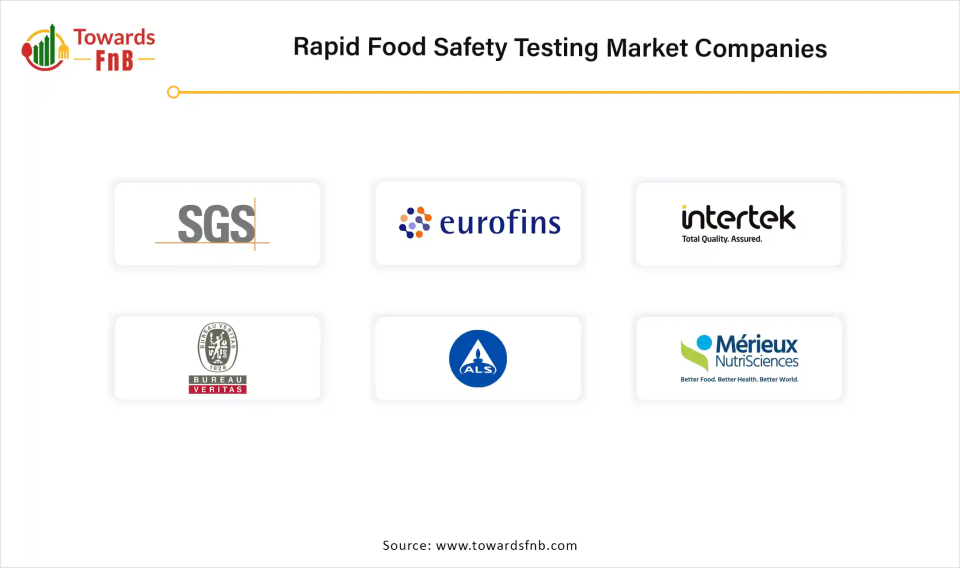November 2025
The global rapid food safety testing market size reached at USD 10.88 billion in 2024 and is anticipated to increase from USD 11.79 billion in 2025 to an estimated USD 24.37 billion by 2034, witnessing a CAGR of 8.4% during the forecast period from 2025 to 2034. The rapid food safety testing market is driven by the increasing demand for sustainability and safe food supply which may enhance global market growth.

| Study Coverage | Details |
| Growth Rate from 2025 to 2034 | CAGR of 8.4% |
| Market Size in 2025 | USD 11.79 Billion |
| Market Size in 2026 | USD 12.78 Billion |
| Market Size by 2034 | USD 24.37 Billion |
| Largest Market | Asia Pacific |
| Base Year | 2024 |
| Forecast Period | 2025 to 2034 |
| Regions Covered | North America, Europe, Asia-Pacific, Latin America, and Middle East & Africa |
The rapid food safety testing market covers fast-turnaround analytical tools, consumables, and services used to detect biological, chemical, and physical hazards in food and beverage products. These methods deliver actionable results within minutes to hours (vs. traditional culture-based tests that can take days). Core technologies include lateral flow immunoassays, ELISA, PCR/qPCR, isothermal amplification (e.g., LAMP), ATP bioluminescence, biosensors, and rapid chromatography.
Use cases span pathogen detection, allergen verification, toxin and chemical residue screening, GMO testing, and hygiene monitoring across processing plants, labs, distribution centers, retail, and foodservice. Rapid testing supports regulatory compliance, brand protection, and real-time quality control.
The rapid food safety testing market is also driven by greater efficiency and improved accuracy in identifying contaminants and foodborne pathogens. This is necessary for ensuring consumer health, enhancing operational efficiency and reducing recall risks. In addition, increasing complexity of global food supply chain, rising advancements in technologies such as biosensors, immunoassays and PCR and increasing specificity and sensitivity are also a growth factors expected to drive the growth of the rapid food safety testing market.
One of the major opportunities revolutionizing the market growth is the rising technological advancements in rapid food safety testing. To control and prevent the prevalence of foodborne diseases, fast and accurate microbiological testing plays an important role in the food industry. The rising innovative scientific techniques allowing real-time results for the prevalence of toxic microbial contaminants in food industry, which may creates major opportunities.
In addition, rising advanced technologies such as spectrometry and chromatography and immunoassay ensure the detection of chemical and biological food contaminants which further driving the food safety and increased adoption. Furthermore, with researchers and scientists exploring more faster and efficient technologies, the range of microbiological methods and accessible chemical for safety testing is continuous to grow rapidly. These cutting-edge factors are expected to revolutionize the growth of the rapid food safety testing market in the coming years.
One of the major restraining factors hindering the market growth is the high equipment costs in rapid food safety testing. The lack of skilled labor and high cost of equipment are the major factors impacting the market growth and may create challengers in operating such advanced machines. Traditional equipment, like Mass Spectrometry, Gas Chromatography, and Liquid Chromatography Mass Spectrometry and others are highly technical and advanced but has very high cost, which consumers can not afford these equipment, further reduces the sales of rapid food safety testing. These factors are expected to restrain the growth of the rapid food safety testing market.
How Asia Pacific Dominates the Rapid Food Safety Testing Market Revenue in 2024?
Asia Pacific dominated the market revenue for rapid food safety testing in 2024. The market growth in the region is attributed to the factors such as the increasing strict regulations of food testing, growing food production, increasing prevalence of foodborne illnesses, increasing demand for ready-to-eat and processed food sectors, increasing awareness of food safety and increasing demand for microbiological testing. China, India, Japan and South Korea are dominating countries driving the market growth.
India Rapid Food Safety Testing Market Trends
India dominated the rapid food safety testing market revenue in 2024. As people’s knowledge of food health and safety issues are increase, the need for significant food testing labs has increased rapidly in India. Consumers are becoming more picky about what they eat and food manufacturers must follow strict safety regulations. The food testing lab in plays an important role in addressing various problems, by guaranteeing, certifying and testing adherence to international and national standards in India.
A food testing lab is a recognized establishment that assesses food samples for quality, safety and compliance in India. Testing laboratories follow the rules set forth by authorities such as ISO (International Organization for Standardization), NABL (National Accreditation Board for Testing and Calibration Laboratories) and FSSAI (Food Safety and Standards Authority of India)

North America is Expected to Grow Fastest During the Forecast Period.
The market growth in the rapid food safety testing market is driven by factors such as the increasing prevalence of foodborne illnesses, enhanced traceability, improved efficiency, reducing testing time, rising integration of automation and AI, increasing consumer awareness towards food safety, increasing demand for safer food and rising technological advancements in rapid testing, such as biosensors, immunoassays and PCR. The U.S. and Canada are the fastest growing countries propelling the market growth. The U.S. is expected to grow fastest during the forecast period. Due to the robust financial strength and consumer demand, the U.S. is one of the major leading food-importing country across the globe.
How PCR/qPCR Segment Dominates the Rapid Food Safety Market Revenue in 2024?
The PCR/qPCR segment dominated the market in 2024. The segment growth in the market is attributed to the various benefits such as the increasing real-time monitoring, enhanced specificity and sensitivity, reduces the time needed for pathogen detection, increasing applications in food safety, increasing benefits for food industry, and enhanced consumer experience. In addition, due to specificity, sensitivity and speed in detecting contaminants and foodborne illnesses, qPCR and PCR plays an important role in rapid food safety testing. These techniques enables for the instant quantification and identification of toxins, microorganisms and GMOs in food samples, which expected to drive the segment growth in the global market.
The Isothermal Amplification Segment is Expected to Grow Fastest During the Forecast Period.
The segment growth in the global rapid food safety testing market is driven by factors such as increasing prevalence of foodborne illnesses, increasing demand for early detection of portable testing kits, simpler workflows and pathogens, and increasing need for expensive thermal cyclers. In addition, due to the rapid efficiency and speed of isothermal amplification techniques such as RPA and LAMP, they are gaining popularity in rapid food safety testing. These factors are expected to enhance the growth of the market.
Why Benchtop Rapid Instruments & Assay Kits Segment Held the Largest Rapid Food Safety Testing Market Revenue in 2024?
The segment growth in the global market is driven by factors such as improved accuracy, cost-effectiveness, versatility, ease of use, extended shelf life, and increasing number of rapid testing methods. In addition, by enabling cost-effectiveness, more accurate and faster analysis of food products for contaminants and pathogens, benchtop rapid assay kits and instruments are revolutionizing food safety testing. These tools, such as rapid test kits and other PCR systems are important for enhancing food quality and safety in various sectors. These factors are expected to drive the segment growth in the rapid food safety testing market during the forecast period.
The Portable/Handheld Devices & Readers Segment is Expected to Grow Fastest During the Forecast Period.
The portable/handheld devices & readers plays an important role in rapid food safety testing. They are providing quick results and on-site analysis for various quality parameters and contaminants and rapidly used in rapid food safety testing. The portable/handheld devices & readers are especially crucial in diverse settings such as in-home setting, markets and food processing facilities. These factors are expected to propel the segment growth in the global market.
What Factors Help Food & Beverage Manufacturers/Processors Segment Grow in 2024?
The food and beverage manufacturers/processors segment dominated the rapid food safety testing market in 2024. The segment growth in the global market is attributed to the factors such as ensuring product safety and quality, increasing prevalence of foodborne illnesses, meeting regulatory compliance, building consumer trust, enhancing operational efficiency and reducing product costs and recalls. In addition, food & beverage manufacturers/processors plays an important role in rapid food safety testing. The help to meet regulatory needs, ensure product quality, and address potential hazards. Furthermore, rapid testing methods help to maintain consumer trust, reduce product recalls and help prevent foodborne illnesses, which further expected to drive the segment growth in the global market.
The Independent & Contract Testing Laboratories Segment is Expected to Grow Fastest During the Forecast Period.
The segment growth in the global rapid food safety testing market is driven by factors such as increasing consumer satisfaction, regulatory compliance, ensuring the integrity of the food safety process, increasing scalability and flexibility, cost-effectiveness and rising technological advancements. In addition, these labs plays an important role in building consumer confidence, focus on product safety and identifying potential hazards, which further drives the segment growth.
How Direct Sales (OEM to Enterprise) Segment Dominates the Rapid Food Safety Testing Market Revenue in 2024?
The direct sales (OEM to Enterprise) segment dominated the market share in 2024. The segment growth in the market is attributed to the increasing demand for offline stores, increasing need for quick delivery, increasing demand for specialized testing equipment, increasing faster support and service, and increasing strong relationships with food manufacturers.
The Online B2B Platforms Segment is Expected to Grow Fastest During the Forecast Period.
The segment growth in the global rapid food safety testing market is driven by various factors such as increasing busy and changing lifestyles, growing e-commerce platforms, increasing desire to shop online, rising rapid integration of internet connectivity.
Raw Material Procurement
Packaging and Branding
Waste Management and Recycling

By Technology
By Product Format
By End User
By Distribution Channel
By Region
The global dextrins market size is projected to expand from USD 3.40 billion in 2025 to USD 4.72 billion by 2034, growing at a CAGR of 3.7% during the...
The global fermentation enzymes market is projected to climb from USD 7.39 billion in 2025 to USD 15.02 billion by 2034, recording a CAGR of 8.2% duri...
The global resistant dextrin market size is projected to witness strong growth from USD 0.45 billion in 2025 to USD 0.92 billion by 2034, reflecting a...
The global duck meat market size is rising from USD 3.40 billion in 2025 to USD 5.89 billion by 2034. This projected expansion reflects a compound ann...
November 2025
November 2025
November 2025
November 2025